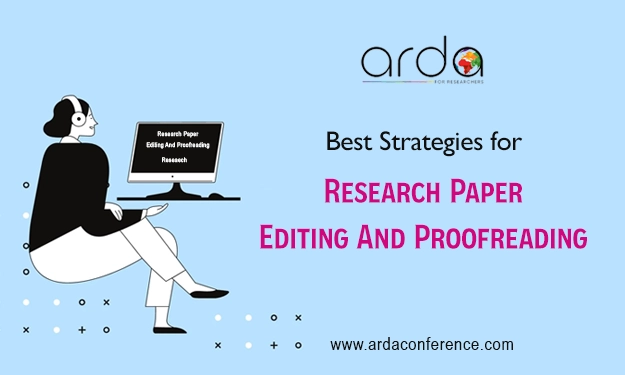Best Strategies for Research Paper Editing And Proofreading
Looking for some tried-and-tested strategies for academic proofreading and editing? You’re in the right place! Here, we’re going to share expert’s strategies for reviewing your paper.
Academic proofreading and editing your research paper are two of the most important steps in the whole process. Although this can be a time-consuming process, this step is critical as it helps identify errors and ambiguities that may otherwise lead to rejections.

In this blog, we’ve compiled the most important and proven strategies to effectively edit and proofread your paper. Let’s get started:
Give it a break
If you’ve been working on the same document for hours or days and then try to proofread it right away, it can be difficult to notice mistakes. So, if you’ve enough time, keep your paper aside for a few hours or a couple of days.
Then, you’ll gain a fresh perspective and be able to proofread the document with renewed attention. If you’re on a strict deadline, giving your paper a break for an hour should also help. Otherwise, leave it aside overnight.
Find a quiet place to concentrate
Editing and academic proofreading a research document demands greater attention and focus. So, you need a place where you can fully concentrate on the document at hand. This is especially true if you’re working at home or have kids around you. Also, put aside your phone to keep any distractions at bay.
When there is no background noise or distractions that could steal your attention, you’ll be able to read the paper out loud. Reading aloud is another proven strategy to make sure you don’t miss any errors.
Check your paper for consistency
Consistency of your document is as important as the content quality. This includes uniformity in presentation, tone, tense usage, perspective, and formatting elements like font style and bullet points. Make sure you’ve evenly and uniformly applied all these elements across your document. It enhances the smooth readability of your paper while delivering a professional and coherent paper presentation.
Please note that inconsistencies in a research paper can cause distractions while undermining your message’s impact. So, make sure you pay attention to these aspects during the proofreading and editing process.
Check for one type of error at a time
Try tackling multiple errors in a single read-through, and you’ll be confused. This is for sure! So, focusing on one type of error at a time can reduce your time proofreading while enhancing accuracy. You may call it a segmented approach.
- Check for spelling errors to make sure every word is correct.
- Check for grammar, focusing on sentence structure and syntax.
- Then, check the document for punctuation.
Isolating these elements will minimize the risk of overlooking errors, resulting in more focused and thorough editing, which will further yield a finished final document.
Edit your document backward
Another important strategy to review your document is to proofread and edit it backward. So, start from the last paragraph and keep reading in the reserved order to the beginning of the paper. So, instead of focusing on the text and the relevancy of the content, you’ll stay more focused on the text’s meaning. This helps you notice clumsy transitions, missing words, repetitive information or words, and so on.
Reserve reading is especially useful for identifying complex sentences and ensuring consistent grammar. So, you’ll achieve a high level of precision in writing, thus improving the overall quality of your document.
Consider peer review
Peer review can be a game-changing strategy when it comes to editing and proofreading your document. An external perspective can help uncover ambiguities that may otherwise go unnoticed.
An external review brings a fresh approach and understanding of the same subject, often catching ambiguous logic as well as grammar and spelling mistakes. You get valuable and honest feedback on the flow of your paper’s content.
Make sure you choose someone for peer review who is trustworthy and familiar with your target audience. So, you’ll get relevant and constructive feedback, helping you enhance the impact of your paper. We encourage you to work with the best academic proofreading services for reliable assistance.
Edit a hard copy
Reviewing a printed physical copy gives your eyes a break from extended periods of screen glancing. It’s worth noting that when eyes become screen-fatigued, it’s very easy to overlook even obvious errors. On the other hand, printed paper changes the format and visual texture. So, it often becomes easier to notice mistakes previously omitted on a computer.
In addition, printed text looks different when it comes to spacing and layout. So, it can highlight issues with formatting, line breaks, paragraph structure, and more. This strategy encourages a slower and more deliberate reading pace, helping detect subtle errors and inconsistencies in your document.
Final strategy: take regular breaks from editing
You cannot effectively proofread and edit a detail-oriented document in a couple of hours in one go. So, it’s important to schedule breaks from editing to keep your attention from waning. Moreover, staying focused on a paper for too long can cause eye fatigue, thus making it difficult to spot errors. So, take time to step away allowing you to maintain your focus on the draft.
Final Thoughts
Now, you know the best strategy for research paper editing and proofreading, so follow them to write the best paper for publishing in top journals. You can also get help from the best writing services to write the perfect paper in one go. Also, reach us for proofreading and editing of the paper.
